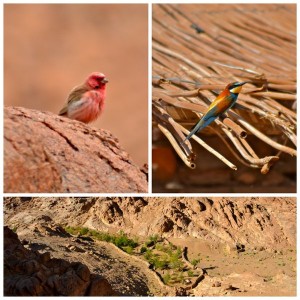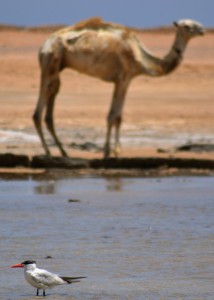Week 28 – 22 January 2017:
From England, to the Sinai, and Beyond
For birds of many species, migration is not optional. In the non-breeding season, conditions on their breeding territories become so extreme that either their needs are not met or their tolerances are exceeded. An English country garden, alive with birdsong in spring is likely to fall silent when winter drives birds south in search of more clement circumstances. Fly away, little feathered friend, or suffer the consequences.
The biggest challenge of migration may not be the journey itself, but the need to find suitable stop-over habitat along the way. If the migratory route is a long one, birds will need to stop for rest and replenishment along the way. Suitable habitat for a short break can be hard to find, particularly if much of the migratory route is over desert.
Andrew Power, Olivia Norfolk and Francis Gilbert of the University of Nottingham in England recently published a paper concerning the value of Bedouin gardens in the southern Sinai to both migratory and resident birds. Power and crew were not in Egypt to just to study birds; the main purpose of their expedition was to collect data on a rare butterfly, the Sinai hairstreak, whose populations are considered to be vulnerable to extinction by the International Union for the Conservation of Nature. Since the researchers were in the region anyway, they took advantage of the opportunity to record their sightings of birds.
The work was completed in the Sinai’s St. Katherine protectorate, essentially a national park, but with added importance. Some birds were noted in the irrigated, managed gardens of the local Bedouin people. Other birds were seen in valley beds and on mountain slopes, habitat which is not managed for agriculture.
In response to an inquiring email message, Power described the circumstances of his field experiences. “I spent long periods of time camping with the Bedouin in the mountains, or in a tourist camp run by the Bedouin.” The camp was very close to St. Catherine’s Monastery, which Power visited several times.
Over a five month period, the research crew documented fifty-one species of birds. Of these, 65% were migrants. Birdlife in the managed gardens was particularly rich. Among the frugivorous birds drawn to the apricots, plums and mulberries of the garden were Golden Orioles and Hooded Wheatears. Garden insects drew in Spotted Flycatchers and Common Redstarts. The gardens were important to resident species too; Collared Doves, Laughing Doves and House Sparrows were seen there, but never in unmanaged habitat. Beyond food and water in the gardens, some bird species utilized Bedouin structures. Power explained to me that Rock Martins and White-crowned Black Wheatears constructed their nests in the walls and on the eaves and sides of houses, taking advantage of almost any crevice.
The St. Katherine protectorate is clearly important for birdlife in the area, and Bedouin gardens, described by Power et al. as “oasis-like,” seem particularly important throughout the year. The Bedouin people collect rainwater to increase the productivity of their mountain gardens, and this action provides much-needed resources for both resident and migratory birds.
A surprisingly large proportion of the migratory bird species that were seen in the Sinai are known to bird enthusiasts in England. If global climate change causes Egypt to become hotter and drier as predicted, the gardens managed by Bedouins may become even more important for wildlife. From the bird’s point of view, it is regrettable that traditional gardening practices are becoming more difficult as Bedouins come to rely more on paid employment. Water is a limited commodity, and tourism and an increasing local population are likely to put further demands on that precious resource.
Power, A., O. Norfolk and F. Gilbert. 2016. The oasis effect: bedouin gardens benefit resident and migratory birds in southern Sinai, Egypt. Sandgrouse 38:7-11.
Photo credits: Dr Andrew Power, https://twitter.com/aerpower?lang=en (set of three photos above) and https://crowcragproductions.com/photos-2/egypt/ (Caspian Tern, below)



